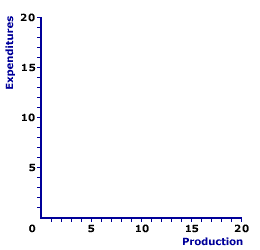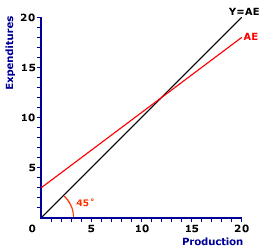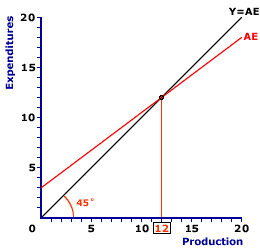
|
|
PRICE ELASTICITY OF DEMAND: The relative response of a change in quantity demanded to a relative change in price. More specifically the price elasticity of demand can be defined as the percentage change in quantity demanded due to a percentage change in demand price. The price elasticity of demand should be compared with the price elasticity of supply.
Visit the GLOSS*arama
|
|


|

|
                           KEYNESIAN EQUILIBRIUM: The state of macroeconomic equilibrium identified by the Keynesian model when the opposing forces of aggregate expenditures equal aggregate production achieve a balance with no inherent tendency for change. Once achieved, a Keynesian equilibrium persists unless or until it is disrupted by an outside force, especially changes in autonomous expenditures. Macroeconomic equilibrium is achieved in the Keynesian model by a balance of aggregate production and aggregate expenditures. As with other economic models, equilibrium in the Keynesian model is a state that exists when two opposing forces exactly offset one another such that nothing changes until or unless an outside force intervenes.Aggregate ForcesThe two opposing forces that achieve equilibrium in the Keynesian model of macroeconomics are aggregate production and aggregate expenditures.- Aggregate Production: The first half of the balance is aggregate production, the total quantity of final goods and services produced in the economy. This total or aggregate production is most commonly measured by gross domestic product.
- Aggregate Expenditures: The other half of the equilibrium balance is aggregate expenditures, the combined expenditures on final goods and services undertaken by the four macroeconomic sectors (household, business, government, and foreign). The four aggregate expenditures (and their common abbreviation) are: consumption expenditures (C), investment expenditures (I), government purchases (G), and net exports (X - M). Aggregate expenditures are commonly represented by an simple equation:
A couple of points about Keynesian equilibrium are worth a note:- First, the adjustment mechanism that achieves and maintains equilibrium is aggregate production. If aggregate expenditures are not equal to aggregate production, then aggregate production changes to restore balance.
- Second, Keynesian equilibrium is ONLY a balance between aggregate expenditures and aggregate production. Other aggregate markets, especially resource markets, need not be in equilibrium. Shortages and surpluses can exist and persist in resource markets. In other words, full employment is NOT automatically achieved with Keynesian equilibrium.
Setting the Keynesian Stage| Keynesian Cross | 
| Equilibrium | 
| Disequilibrium | 
|
The best way to illustrate Keynesian equilibrium is with the Keynesian cross intersection between the aggregate expenditures line (AE) and the 45-degree (Y = AE) line.Consider the exhibit to the right. This illustrates the standard framework for the Keynesian model, with aggregate production measured on the horizontal axis and aggregate expenditures measured on the vertical axis. - One of two items needed to identify equilibrium is the 45-degree guideline. This can be displayed by clicking the [45-Degree Line] button. The resulting line is labeled Y = AE.
- The other item needed is the aggregate expenditures line. This can be displayed by clicking the [Aggregate Expenditures Line] button. The resulting line is labeled AE.
An Intersecting EquilibriumWith both lines in place, the next step is to identify equilibrium, which can be accomplished using the exhibit to the right. Equilibrium in the Keynesian model is achieved at the intersection of the 45-degree line and the aggregate expenditures line. Click the [Equilibrium] button to identify this point and corresponding aggregate production. - Equilibrium is achieved with $12 trillion of aggregate production. At this level, aggregate expenditures are also $12 trillion.
- Only at $12 trillion are aggregate expenditures equal to aggregate production. At every other production level, aggregate expenditures are either greater than or less than aggregate production.
- At this $12 trillion level, there are no economy-wide surpluses or shortages because buyers buy all they want and sellers sell all they have.
- The lack of surpluses and shortages means equilibrium. Neither buyers nor sellers are dissatisfied with this condition, and thus have no reason to alter the production level.
- A key indicator of this equilibrium is business inventories -- stockpiles of raw materials and finished goods. The business sector has no unexpected, or unplanned, changes in inventories.
Out of BalanceOnce the Keynesian model achieves equilibrium it remains in equilibrium. But what happens if the level of aggregate production does not achieve equilibrium? What if aggregate production is less than or greater than that needed for equilibrium? Fortunately, the Keynesian model has a stable equilibrium. That is, should the model not be in equilibrium it moves toward equilibrium.Disequilibrium in the Keynesian model results when aggregate expenditures are not equal to aggregate production. More specifically, this is an aggregate production level that does not coincide with the intersection of the aggregate expenditures line and the 45-degree line. A graphical analysis of disequilibrium is in order. The exhibit to the right displays equilibrium in the Keynesian model. Aggregate production is $12 trillion at the intersection of the aggregate expenditures line and the 45-degree line. If aggregate production is greater than or less than $12 trillion, we have disequilibrium. Let's consider each alternative. - Greater Than $12 Trillion: Suppose aggregate production is $18 trillion. Click the [$18 Trillion] button to highlight this alternative. At $18 trillion, the aggregate expenditures line lies beneath the 45-degree line and aggregate expenditures are $16.5 trillion, less than aggregate production.
The difference between aggregate expenditures and aggregate production means that economy-wide production surpluses exist. Economy-wide surpluses result in unplanned increases in inventories because the business sector sells less output than current production. The $1.5 trillion vertical distance between the aggregate expenditures line and the 45-degree line indicates the increase in business inventories. The build-up of inventories motivates the business sector to reduce aggregate production. The decrease in aggregate production then moves the economy to the $12 trillion equilibrium level. In the course of this adjustment, aggregate expenditures decline from $16.5 trillion to $12 trillion.
- Less Than $12 Trillion: Now suppose aggregate production is $6 trillion. Click the [$6 Trillion] button to highlight this alternative. At $6 trillion, the aggregate expenditures line lies above the 45-degree line and aggregate expenditures are $7.5 trillion, greater than aggregate production.
The difference between aggregate expenditures and aggregate production means that economy-wide production shortages exist. Economy-wide shortages result in unplanned decreases in inventories because the business sector sells more output than current production. The $1.5 trillion vertical distance between the aggregate expenditures line and the 45-degree line indicates the decrease in business inventories. The reduction of inventories motivates the business sector to increase aggregate production. The increase in aggregate production then moves the economy to the $12 trillion equilibrium level. In the course of this adjustment, aggregate expenditures rise from $7.5 trillion to $12 trillion.
Changes in business inventories play a key role in the adjustment to equilibrium by signalling the business sector to increase or decrease aggregate production. For this reason, those who track the ups and downs of business cycles tend to keep a close eye on business inventories. A sudden and unexpected drop is a likely sign of an expansion of the economy. A sudden and unexpected rise is a likely sign of a contraction.

Recommended Citation:KEYNESIAN EQUILIBRIUM, AmosWEB Encyclonomic WEB*pedia, http://www.AmosWEB.com, AmosWEB LLC, 2000-2025. [Accessed: July 18, 2025].
Check Out These Related Terms... | | | | | | | | | | |
Or For A Little Background... | | | | | | | | | | |
And For Further Study... | | | | | | | | | | | | |
Search Again?
Back to the WEB*pedia
|



|

|
YELLOW CHIPPEROON
[What's This?]
Today, you are likely to spend a great deal of time searching the newspaper want ads trying to buy either a T-shirt commemorating the 2000 Olympics or a genuine fake plastic Tiffany lamp. Be on the lookout for telephone calls from former employers.
Your Complete Scope
This isn't me! What am I?
|

|
|
The average bank teller loses about $250 every year.
|

|
|
"A winner is someone who recognizes his God-given talents, works his tail off to develop them into skills, and uses those skills to accomplish his goals. " -- Larry Bird, basketball player
|

|
BLS
Bureau of Labor Statistics
|

|
|
Tell us what you think about AmosWEB. Like what you see? Have suggestions for improvements? Let us know. Click the User Feedback link.
User Feedback
|


|


